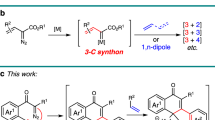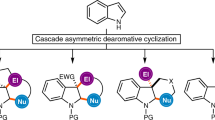Abstract
The development of multiple-component cross-coupling reactions is a challenge due to issues of selectivity and efficiency. In the present study, we report a chromium-catalysed, multicomponent cross-coupling reaction for the synthesis of tertiary hydrocarbons using two distinct electrophiles and one nucleophile. The tertiary alkane reaction products are important three-dimensional space structures and prevalent in a variety of drugs and bioactive molecules. The strategy comprises two cross-coupling processes of inactivated geminal C–O and C–H bonds with arylmagnesium reagents and several electrophiles, enabling the inhibition of competitive side couplings to achieve high selectivity and diversification by chromium catalysis. The synthetic scope of the multicomponent process was demonstrated through the selective synthesis of a range of diarylated tertiary silanes and difluoroallylated and alkylated alkanes. The process was also found to be readily scalable and could be applied to the synthesis of market-selling drugs, anticancer agents and bioactive molecules. Mechanistic studies revealed an amphipathic diheterometalloalkane intermediate by incorporating two distinct functional groups in the formation of tertiary hydrocarbons.

This is a preview of subscription content, access via your institution
Access options
Subscribe to this journal
Receive 12 digital issues and online access to articles
$119.00 per year
only $9.92 per issue
Buy this article
- Purchase on Springer Link
- Instant access to full article PDF
Prices may be subject to local taxes which are calculated during checkout






Similar content being viewed by others
Data availability
Experimental details, nuclear magnetic resonance spectra and theoretical studies files are included as Supplementary Information.
References
de Meijere, A. & Diederich, F. (eds) Metal-Catalyzed Cross-Coupling Reactions 2nd edn, Vol. 2 (Wiley-VCH, 2004).
Negishi, E.-i Transition metal-catalyzed organometallic reactions that have revolutionized organic synthesis. Bull. Chem. Soc. Jpn 80, 233–257 (2007).
Johansson Seechurn, C. C. C., Kitching, M. O., Colacot, T. J. & Snieckus, V. Palladium-catalyzed cross-coupling: a historical contextual perspective to the 2010 Nobel Prize. Angew. Chem. Int. Ed. 51, 5062–5085 (2012).
Choi, J. & Fu, G. C. Transition metal–catalyzed alkyl-alkyl bond formation: another dimension in cross-coupling chemistry. Science 356, eaaf7230 (2017).
Klinman, J. & Hammes-Schiffer, S. (eds) Dynamics in Enzyme Catalysis Vol. 337 (Springer, 2013).
Zhu, J. & Bienaymé, H. (eds) Multicomponent Reactions (Wiley-VCH, 2005).
Miyaura, N. & Suzuki, A. Palladium-catalyzed cross-coupling reactions of organoboron compounds. Chem. Rev. 95, 2457–2483 (1995).
Liu, L. et al. General method for iron-catalyzed multicomponent radical cascades–cross-couplings. Science 374, 432–439 (2021).
Kumar, R., Flodén, N. J., Whitehurst, W. G. & Gaunt, M. J. A general carbonyl alkylative amination for tertiary amine synthesis. Nature 581, 415–420 (2020).
Blacker, J. A. & Williams, M. T. (eds) Pharmaceutical Process Development: Current Chemical and Engineering Challenges (Royal Society of Chemistry, 2011).
George, K. L. & Horne, W. S. Foldamer tertiary structure through sequence-guided protein backbone alteration. Acc. Chem. Res. 51, 1220–1228 (2018).
Lipinski, C. & Hopkins, A. Navigating chemical space for biology and medicine. Nature 432, 855–861 (2004).
Rudolph, A. & Lautens, M. Secondary alkyl halides in transition-metal-catalyzed cross-coupling reactions. Angew. Chem. Int. Ed. 48, 2656–2670 (2009).
Saito, B. & Fu, G. C. Alkyl−alkyl suzuki cross-couplings of unactivated secondary alkyl halides at room temperature. J. Am. Chem. Soc. 129, 9602–9603 (2007).
Xia, Y., Zhang, Y. & Wang, J. Catalytic cascade reactions involving metal carbene migratory insertion. ACS Catal. 3, 2586–2598 (2013).
Jumde, R. P., Lanza, F., Veenstra, M. J. & Harutyunyan, S. R. Catalytic asymmetric addition of Grignard reagents to alkenyl-substituted aromatic N-heterocycles. Science 352, 433–437 (2016).
Derosa, J., Apolinar, O., Kang, T., Tran, V. T. & Engle, K. M. Recent developments in nickel-catalyzed intermolecular dicarbofunctionalization of alkenes. Chem. Sci. 11, 4287–4296 (2020).
Gao, D.-W. et al. Cascade CuH-catalysed conversion of alkynes into enantioenriched 1,1-disubstituted products. Nat. Catal. 3, 23–29 (2020).
Melhado, A. D., Brenzovich, W. E. Jr., Lackner, A. D. & Toste, F. D. Gold-catalyzed three-component coupling: oxidative oxyarylation of alkenes. J. Am. Chem. Soc. 132, 8885–8887 (2010).
Wang, W., Ding, C. & Yin, G. Catalyst-controlled enantioselective 1,1-arylboration of unactivated olefins. Nat. Catal. 3, 951–958 (2020).
Murai, M. et al. Structural characterization and unique catalytic performance of silyl-group-substituted geminal dichromiomethane complexes stabilized with a diamine ligand. J. Am. Chem. Soc. 139, 13184–13192 (2017).
Okazoe, T., Takai, K. & Utimoto, K. (E)-Selective olefination of aldehydes by means of gem-dichromium reagents derived by reduction of gem-diiodoalkanes with chromium(II) chloride. J. Am. Chem. Soc. 109, 951–953 (1987).
Wang, Z., Guo, C.-Y., Yang, C. & Chen, J.-P. Ag-catalyzed chemoselective decarboxylative mono- and gem-difluorination of malonic acid derivatives. J. Am. Chem. Soc. 141, 5617–5622 (2019).
Hazrati, H. & Oestreich, M. Copper-catalyzed double C(sp3)–Si coupling of geminal dibromides: ionic-to-radical switch in the reaction mechanism. Org. Lett. 20, 5367–5369 (2018).
Palmer, W. N., Obligacion, J. V., Pappas, I. & Chirik, P. J. Cobalt-catalyzed benzylic borylation: enabling polyborylation and functionalization of remote, unactivated C(sp3)–H bonds. J. Am. Chem. Soc. 138, 766–769 (2016).
Murai, M., Taniguchi, R., Mizuta, C. & Takai, K. Chromium-mediated stannylcyclopropanation of alkenes with (diiodomethyl)stannanes. Org. Lett. 21, 2668–2672 (2019).
Tollefson, E. J., Hanna, L. E. & Jarvo, E. R. Stereospecific nickel-catalyzed cross-coupling reactions of benzylic ethers and esters. Acc. Chem. Res. 48, 2344–2353 (2015).
Nattmann, L., Lutz, S., Ortsack, P., Goddard, R. & Cornella, J. A highly reduced Ni–Li–olefin complex for catalytic Kumada–Corriu cross-couplings. J. Am. Chem. Soc. 140, 13628–13633 (2018).
Li, J. & Knochel, P. Chromium-catalyzed cross-couplings and related reactions. Synthesis 51, 2100–2106 (2019).
Cong, X. & Zeng, X. Mechanistic diversity of low-valent chromium catalysis: cross-coupling and hydrofunctionalization. Acc. Chem. Res. 54, 2014–2026 (2021).
Agapie, T. Selective ethylene oligomerization: recent advances in chromium catalysis and mechanistic investigations. Coord. Chem. Rev. 255, 861–880 (2011).
Franz, A. K. & Wilson, S. O. Organosilicon molecules with medicinal applications. J. Med. Chem. 56, 388–405 (2013).
Ramesh, R. & Reddy, D. S. Quest for novel chemical entities through incorporation of silicon in drug scaffolds. J. Med. Chem. 61, 3779–3798 (2018).
Ciriminna, R. et al. The sol–gel route to advanced silica-based materials and recent applications. Chem. Rev. 113, 6592–6620 (2013).
Rémond, E., Martin, C., Martinez, J. & Cavelier, F. Silicon-containing amino acids: synthetic aspects, conformational studies, and applications to bioactive peptides. Chem. Rev. 116, 11654–11684 (2016).
Barzan, C. et al. Ligands make the difference! molecular insights into CrVI/SiO2 phillips catalyst during ethylene polymerization. J. Am. Chem. Soc. 139, 17064–17073 (2017).
Steib, A. K., Kuzmina, O. M., Fernandez, S., Flubacher, D. & Knochel, P. Efficient chromium(II)-catalyzed cross-coupling reactions between Csp2 centers. J. Am. Chem. Soc. 135, 15346–15349 (2013).
Vasilopoulos, A., Zultanski, S. L. & Stahl, S. S. Feedstocks to pharmacophores: Cu-catalyzed oxidative arylation of inexpensive alkylarenes enabling direct access to diarylalkanes. J. Am. Chem. Soc. 139, 7705–7708 (2017).
Ameen, D. & Snape, T. J. Chiral 1,1-diaryl compounds as important pharmacophores. Med. Chem. Commun. 4, 893–907 (2013).
Wu, Z., Gockel, S. N. & Hull, K. L. Anti-Markovnikov hydro(amino)alkylation of vinylarenes via photoredox catalysis. Nat. Commun. 12, 5956 (2021).
Wang, J. et al. Fluorine in pharmaceutical industry: fluorine-containing drugs introduced to the market in the last decade (2001–2011). Chem. Rev. 114, 2432–2506 (2014).
Meanwell, N. A. Synopsis of some recent tactical application of bioisosteres in drug design. J. Med. Chem. 54, 2529–2591 (2011).
Magueur, G., Crousse, B., Ourévitch, M., Bonnet-Delpon, D. & Bégué, J.-P. Fluoro-artemisinins: when a gem-difluoroethylene replaces a carbonyl group. J. Fluorine Chem. 127, 637–642 (2006).
Xiong, Y., Luo, M. & Zeng, X. Chromium-catalyzed three-component synthesis of monofluoroalkenes from gem-difluoroalkenes via C−O/C−H and C−F bond activation. Org. Lett. 25, 3120–3125 (2023).
Cornella, J., Zarate, C. & Martin, R. Metal-catalyzed activation of ethers via C–O bond cleavage: a new strategy for molecular diversity. Chem. Soc. Rev. 43, 8081–8097 (2014).
Cong, X., Tang, H. & Zeng, X. Regio- and chemoselective Kumada–Tamao–Corriu reaction of aryl alkyl ethers catalyzed by chromium under mild conditions. J. Am. Chem. Soc. 137, 14367–14372 (2015).
Albahily, K. et al. Vinyl oxidative coupling as a synthetic route to catalytically active monovalent chromium. J. Am. Chem. Soc. 133, 6388–6395 (2011).
Knochel, P., Yeh, M. C. P. & Xiao, C. Preparation and reactivity of mixed benzylic 1,1-dimetalloalkanes. Organometallics 8, 2831–2835 (1989).
Michel, O. et al. Reactivity of permethylated magnesium complexes toward β-diimines. Organometallics 30, 3818–3825 (2011).
Marek, I. & Normant, J.-F. Synthesis and reactivity of sp3-geminated organodimetallics. Chem. Rev. 96, 3241–3268 (1996).
Hills, C. J., Winter, S. A. & Balfour, J. A. Tolterodine. Drugs 55, 813–820 (1998).
Lin, Y.-S., Kuo, Y.-C., Kuei, C.-H. & Chang, M.-Y. Palladium-mediated synthesis of 1,1,2-triarylethanes. Application to the synthesis of CDP-840. Tetrahedron 73, 1275–1282 (2017).
Campos, K. R. et al. The importance of synthetic chemistry in the pharmaceutical industry. Science 363, eaat0805 (2019).
Alexander, R. P. et al. CDP840. A prototype of a novel class of orally active anti-inflammatory phosphodiesterase 4 inhibitors. Bioorg. Med. Chem. Lett. 12, 451–1456 (2002).
Ivelina, M. et al. Stereospecific nickel-catalyzed cross-coupling reactions of alkyl Grignard reagents and identification of selective anti-breast-cancer agents. Angew. Chem. Int. Ed. 53, 2422–2427 (2014).
Lv, X.-Y., Fan, C., Xiao, L.-J., Xie, J.-H. & Zhou, Q.-L. Ligand-enabled Ni-catalyzed enantioselective hydroarylation of styrenes and 1,3-dienes with arylboronic acids. CCS Chem. 1, 328–334 (2019).
Bullock, R. M. et al. Using nature’s blueprint to expand catalysis with Earth-abundant metals. Science 369, eabc3183 (2020).
Acknowledgements
We thank the National Key R&D Program of China (grant no. 2021YFA1500200 to H.C.), the National Natural Science Foundation of China (grant nos. 22125107 and 21971168 to X.Z. and 21871186 to M.L.) and Fundamental Research Funds for the Central Universities (grant no. 20826041D4117 to X.Z.) for financial support. We also thank D. Deng from the College of Chemistry at Sichuan University for nuclear magnetic resonance testing.
Author information
Authors and Affiliations
Contributions
X.Z. designed the overall research project. F.F., M.L. and X.Z. designed and conducted directed evolution experiments. F.F., L.L. and C.L. conducted the studies of substrate scope and mechanistic experiments. L.L. and H.C. performed the computational studies. All authors analysed the data and contributed to the preparation of the paper. X.Z. and H.C. wrote the paper.
Corresponding authors
Ethics declarations
Competing interests
The authors declare no competing interests.
Peer review
Peer review information
Nature Synthesis thanks Robert Pollice and the other, anonymous, reviewer(s) for their contribution to the peer review of this work. Primary Handling Editor: Thomas West, in collaboration with the Nature Synthesis team.
Additional information
Publisher’s note Springer Nature remains neutral with regard to jurisdictional claims in published maps and institutional affiliations.
Supplementary information
Supplementary Information
Experimental details: Supplementary Sections 1–10, Tables 1–9 and Figs. 1–7.
Supplementary Data 1
Cartesian coordinates for the DFT calculations.
Rights and permissions
Springer Nature or its licensor (e.g. a society or other partner) holds exclusive rights to this article under a publishing agreement with the author(s) or other rightsholder(s); author self-archiving of the accepted manuscript version of this article is solely governed by the terms of such publishing agreement and applicable law.
About this article
Cite this article
Fan, F., Long, L., Ling, L. et al. Chemoselective chromium-catalysed cross-coupling enables three-component tertiary alkane synthesis. Nat. Synth 2, 1046–1058 (2023). https://doi.org/10.1038/s44160-023-00364-w
Received:
Accepted:
Published:
Issue Date:
DOI: https://doi.org/10.1038/s44160-023-00364-w
This article is cited by
-
Chromium delivers twice
Nature Synthesis (2023)



